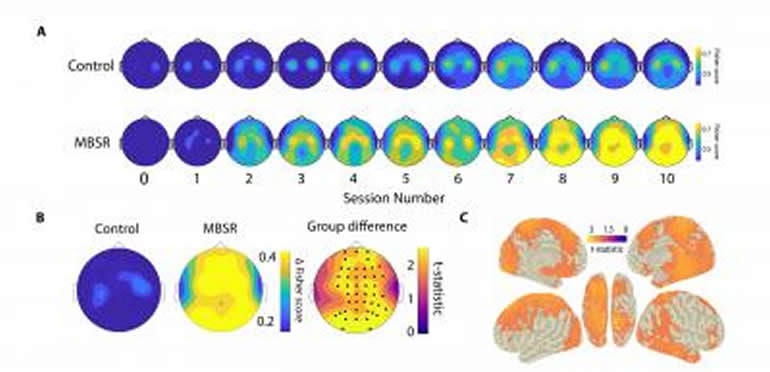Seminar Papers
Summary: The study into the relationship between physical function and working memory is actively underway. In this paper, they tried to find the relationships between cardiorespiratory fitness, gait speed, hand dexterity, muscular strength with N-back performance as a working memory task. The results illustrate that FPN and DMN are activated by task-evoked functional activity and the cardiorespiratory fitness and hand dexterity contribute to enhance this activation.
Summary: The auditory-verbal hallucination by change of brain network function has been reported from schizophrenia patients. The goal of the paper is to investigate the modulation by neurofeedback in resting-state connectivity. They demonstrated the coupling increased between language and DMN node after the down-regulation NF. Also, they showed the possibility of NF as a therapeutic intervention
Summary: In this paper, lower limb somatotopy mapping was investigated whether each mapped representation also responded to the stimulation of other body parts (i.e., response selectivity) and conducted dissimilarity analysis relating these anatomical and functional properties of S1 to the physical structure of the lower limbs. They found only minor differences between the properties of the three BAs of somasensory areas (i.e., BA 3,1,2), suggesting that S1 maps for the lower limbs differ from those described for the hand. Furthermore, this paper suggested a possible homology between the first digit of upper and lower extremity in humans, and report different patterns of selectivity in the foot representations (i.e. lower selectivity) compared to the other leg representations (i.e. greater selectivity)

Astrocytes help transition the brain from a highly plastic state to one that is more stable.
Separating vascular cell data based on sex helps researchers make new discoveries about why males and females are affected by neurodegenerative* diseases differently. Findings point to differences in the blood-brain barrier between males and females.
*neurodegenerative : the progressive loss of structure or function of neurons, including their death

A new study, that utilized machine learning tools, provides a new map that links genetic signatures to functions across the human brain!
Interestingly, they found a clear genetic signal that separated cognitive processes, like attention, from more affective processes, like fear. This separation can be traced to gene expression in specific cell types and molecular pathways, offering key insights for future research into psychiatric disorders.
Cognition, for example, was linked more to the gene signatures of inhibitory or excitatory neurons. Affective processes, however, were linked to support cells such as microglia and astrocytes, supporting a theory that inflammation of these cells is a risk factor in mental illness. The genetic signature related to affect was centred on a brain region called the anterior cingulate cortex, which has been shown to be vulnerable in mental illness.
See the https://www.nature.com/articles/s41562-021-01082-z
Published in the journal Nature Human Behaviour on March 25, 2021
(this study draws a direct link between gene expression and higher brain function, by mapping gene signatures to functional processes across the human brain.)
Johnson, D. D., & Fowler, J. H. (2011). The evolution of overconfidence. Nature, 477(7364), 317-320.

Interestingly, the authors found that overconfidence maximizes individual fitness and populations tend to become overconfident.

The human brain has limited capacity in terms of the data it is able to process and save in its memory. Researchers sought to answer the following question: is the visual system capable of automatic object categorization (i.e., without attention)? To this end, they tested whether the rapid categorical parsing is automatic or requires attention. They found that spatially intermixed objects are parsed into distinct categories automatically.
How Our Visual System Avoids Overloading

Using generative networks and functional magnetic resonance imaging (fMRI), researchers found that brain uses similar visual areas for mental imagery and vision, but it uses low-level visual areas less precisely with mental imagery than with vision. Namely, there are distinct codes for seen and mental images in the brain which can be captured by generative networks.
Is What I See, What I Imagine? The Neural Overlap Between Vision and Imagination
Breedlove, J. L., St-Yves, G., Olman, C. A., & Naselaris, T. (2020). Generative Feedback Explains Distinct Brain Activity Codes for Seen and Mental Images. Current Biology.

The team found that those with training in mindfulness-based attention and training (MBAT) were more successful in controlling the BCI, both initially and over time. Interestingly, the researchers found that differences in brain activity between the two sample groups corresponded directly with their success. The meditation group showed significantly enhanced capability of modulating their alpha rhythm, the activity pattern monitored by the BCI system to mentally control the movement of a computer cursor.
His findings are very important for the process of BCI training and the overall feasibility of non-invasive BCI control via EEG. This work shows that just a short period of MBAT training can significantly improve a subject’s skill with a BCI. This suggests that education in MBAT could provide a significant addition to BCI training.
https://neurosciencenews.com/meditation-mind-control-17071/
Mindfulness Improves Brain–Computer Interface Performance by Increasing Control Over Neural Activity in the Alpha Band James R Stieger, Stephen Engel, Haiteng Jiang, Christopher C Cline, Mary Jo Kreitzer, Bin He